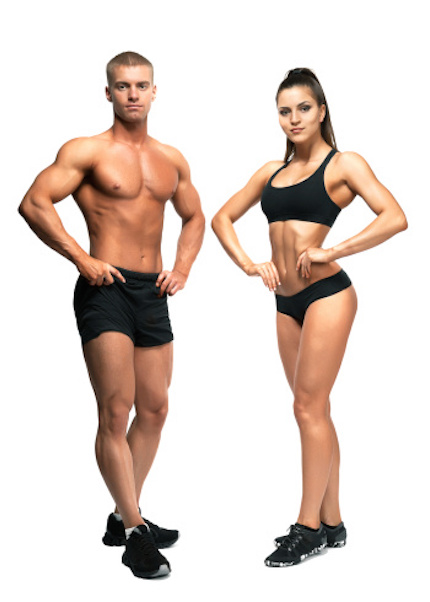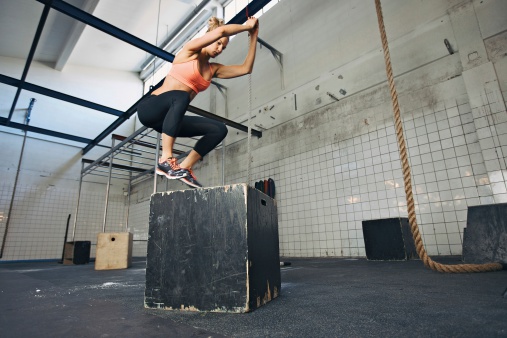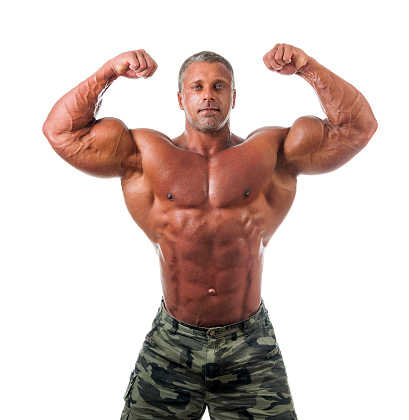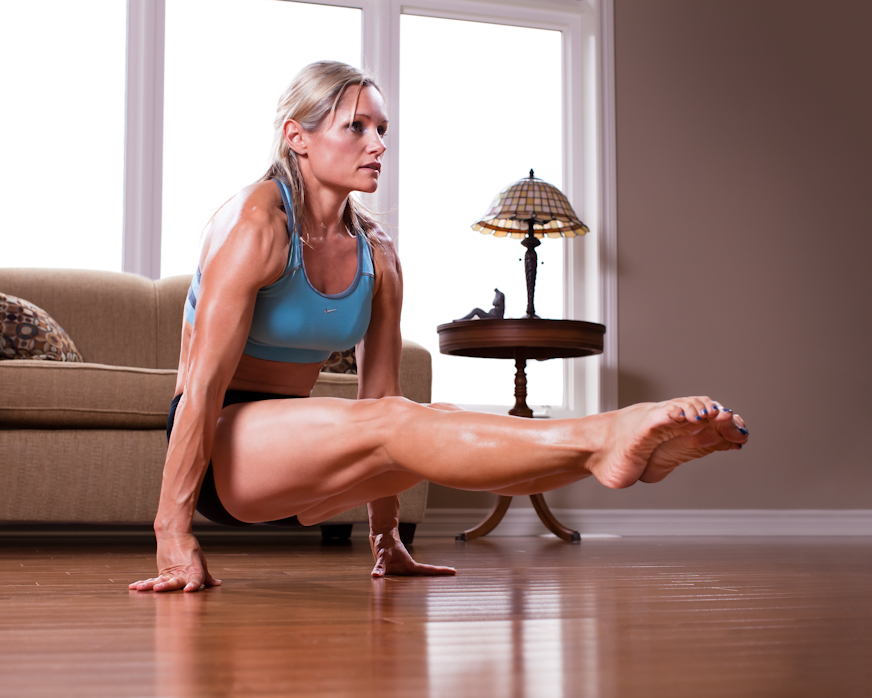Crossfit Vs. Bodybuilding

Warning: This article is geared towards those who have a competitive spirit but lift weights or do CrossFit recreationally, with no immediate goals to get onstage at a competition or compete in the CrossFit Games.
As a bodybuilder, when you hear “CrossFit,” you think, “injuries,” “Rhabdo,” and “#CrossFitFail Youtube videos.” As a CrossFitter, when you hear “bodybuilding,” you think, “steroids,” “vanity,” and “steroids.” But what if we combined the two and thought, “discipline,” “commitment,” and “athletic”? What if bodybuilders embraced the sheer volume, aerobic capacity, and “jack-of-all-trades” type of programming that CrossFit uses, and CrossFitters embraced bodybuilding’s commitment to hypertrophy, aesthetics, and on-season/off-season based dieting? Can’t we all just get along?
Does CrossFit complement bodybuilding, or are they contradictory?
Science has never directly compared or contrasted the two disciplines, but we can. On measures of adherence, how much effect they have on body composition, and how strength programming is mapped out, we can see which method “wins” in an evaluation.

Compare, Contrast, Confuse
Adherence: TIE
Building muscle and losing fat takes more than a day. More than a week. Sometimes—gasp—more than a month! It’s a commitment. It’s a process. “It’s a marathon,” not a sprint. If you want to reach your goal, you have to dedicate yourself day after day. There’s a reason gym memberships are sold on an annual basis; bodybuilding takes time—but we love it. Watching your body change a little more, day after day, watching yourself get stronger each session. It’s genuinely addictive.
Some bodybuilders look at CrossFit, and wonder how they can do “Murph,” “Helen,” or 100 burpees for time, and call that addictive. Believe it or not, science has proven this to be true. In one study, researchers found that a group of participants doing three 60-minute CrossFit sessions “were able to maintain exercise enjoyment and were more likely to intend to continue” than a group assigned three aerobic cardio sessions and two full-body resistance sessions per week.1
Body Composition: TIE
Average stats for top 9 male CrossFitters in the Games,3 and top 5 male bodybuilders in the IFBB4 currently

I know we said we weren’t going to talk about competitors in the Games or IFBB pros, but these stats reflect the ultimate in body composition for each of the two sports. Essentially, this is what you’re looking at if you’re looking up to the best in the world. We still need hard data to compare the physique of a CrossFit athlete against that of a bodybuilder. Dedicated, hardcore gym buffs can get pretty lean by using their knowledge of nutrition and a heavy dose of discipline. They count “macros” and weigh their food because everyone in the bodybuilding world knows that “nutrition is 80 percent” of attaining your goals. In a similar vein, a study was done in 2013 that had both men and women doing CrossFit three times a week for 10 weeks. Men dropped from 22 to 18 percent body fat, and women dropped from 27 to 23 percent. Across 43 participants, body fat percentage dropped 3.7 percent on average, which, relatively speaking, is a pre-training to post-training change of 15.5 percent.5 This isn’t the first study to demonstrate how a high-intensity interval training type of program such as CrossFit can lean you out.6

So through different methodologies (nutrition versus training), both CrossFit and bodybuilding deserve kudos for what they’re able to do to your body’s composition. If we look at the stats, and if you think of your friends who have committed to the bodybuilding/CrossFit lifestyle, you can see that both sets of athletes have exceptionally low levels of body fat. This means that having a lean, athletic physique is something shared between the two sports.
Strength: TIE
Average stats for top 9 male CrossFitters in the Games,3 and top 5 male bodybuilders in the IFBB currently

A lot of people are under the impression that CrossFit is just a lot of running, box jumping, and burpeeing; and they wouldn’t be wrong. But there is always a programmed strength/skill component that comes before the actual WOD. This often gets overlooked when people are trying to find faults in the CrossFit methodology. One particular box in Kitchener, Ontario, lays out its programming online for the upcoming month, and it’s always different. For example, January 2015 announces: “The month is laid out so that you should progress nicely with several different lifts including your back squat, Pendlay row, power clean and bench press. We’ve got … pure aerobic work, and aerobic power work. Each will help condition you well. It’s great to have strength, but if you can’t move quickly and efficiently it’s not that helpful. So along with the strength work there are some met-cons that will get you moving quickly with loads.”
CrossFit has a questionable reputation in the “strength” department because words such as “rhabdomyolysis” and “injuries” are thrown around often. “Rhabdo” is a condition whereby skeletal muscle tissue is damaged, then broken down, then leaks into the bloodstream, potentially leading to kidney failure. If you search online, however, you will not find a published journal article that includes both CrossFit and rhabdomyolysis in the title. There’s one about “The nature and prevalence of injury during CrossFit training,” but even the conclusion of that was “Injury rates with CrossFit training are similar to that reported in the literature for sports such as Olympic weight-lifting, power-lifting and gymnastics, and lower than competitive contact sports such as rugby.”8

The reason there is a question mark in the bodybuilding column is because bodybuilders are often quoted as saying (tongue in cheek), “It’s not about how much you lift; it’s about how much you look like you can lift.” Now, with that said, some of the best bodybuilders in the world have impressive numbers; for example, there are videos online of Kai Greene and Ronnie Coleman squatting upwards of 800 pounds and deadlifting more than 600 pounds. Branch Warren and Johnnie Jackson can also bench more than 500 pounds. Looking at the workouts and the scientific literature regarding CrossFit strength programming (and injury rates), and looking at the sheer size (and YouTube videos) of some bodybuilders, you can see that regardless of how you train, if you’re committed to the process and the program, you will get stronger using CrossFit and bodybuilding.
------------------------------------------------------------------------------------------
Interview with Joanne Mittelholtz, owner of CrossFit Kitchener (11,000 square feet of training space between 2 facilities). Decided to open up CFK in 2009 with her husband, Lance.

How would you describe the culture of CrossFit?
The culture is what makes CrossFit unique compared to a “Globo-gym.” It’s inclusive, it’s supportive, it’s encouraging. Part of the reason is because the workouts are tough. You’re being tested on all levels, and the whole community is in it together. Everyone wants to feel a sense of belonging, and I think that’s what CrossFit gives them. CrossFitters are disciplined and committed (have to be because it’s not inexpensive, and it’s not easy). In any other gym, there isn’t as much motivation, because they don’t always have someone there telling them what to do. People in this environment just want to be better, to better themselves.
Can CrossFit and bodybuilding co-exist?
Absolutely! We have bodybuilders in our program right now who’ve switched over to a CrossFit style of training, and they’ve thrived in our environment without losing strength or mass. The greatest benefit to bodybuilders engaging in a CrossFit program is the functionality and metabolic conditioning aspect. Although CF doesn’t incorporate many isolation-type movements, we do incorporate auxiliary work before the workout portion of the class.
Do you believe that you can train as a CrossFitter and look like a bodybuilder?
It all depends on the goals, body type, and level of expertise of the athlete. If we use a CrossFit Games athlete as an example, although there are many different body types, many of them do look muscular and lean like a bodybuilder. Unlike a recreational CrossFitter, Games athletes train like professional athletes. In CrossFit, our goal is help people be the fittest they can be in all domains of fitness, and the result of this style of training combined with proper nutrition is usually a leaner, fitter, and more muscular body.
A CASE FOR CROSSFIT
“There is nothing either good or bad, but thinking makes it so.”—William Shakespeare
I know what you’re thinking: That was anticlimactic. Call it boring or call it controversial, but bodybuilding and CrossFit tie on the basis of people’s adherence/commitment level, the body composition changes, and the strength improvements. They can absolutely be done in conjunction, simultaneously. There’s nothing shameful about doing CrossFit, with a little bodybuilding on the side. You won’t be any less of an athlete just because you do lateral raises to make your shoulders bigger. And there’s nothing dangerous about bodybuilding, with a little WOD to enhance the workout. You won’t “lose all your gains, bro” or get injured by doing an AMRAP of wall balls, burpees, and ring dips.
References:
1) Heinrich KM, Patel PM, O'Neal JL, Heinrich BS. High-intensity compared to moderate-intensity training for exercise initiation, enjoyment, adherence, and intentions: an intervention study. BMC Public Health. 2014 Aug 3;14:789. doi: 10.1186/1471-2458-14-789.
3) Del Castillo I. How well do you stack against the average stats of the top finishers at the 2014 crossfit games? Web log post. BurpeeZoid. Available at: http://burpeezoid.com/2014/09/02/how-well-do-you-stack-against-the-avera.... Accessed Feb. 22, 2015.
4) Bodybuilding.com - Huge Online Supplement Store & Fitness Community! Bodybuilding.com. Available at: http://bodybuilding.com/. Accessed Feb. 22, 2015.
5) Smith MM, Sommer AJ, Starkoff BE, Devor ST. Crossfit-based high-intensity power training improves maximal aerobic fitness and body composition. J Strength Cond Res. 2013 Nov;27(11):3159-72.
6) Tremblay A1, Simoneau JA, Bouchard C. Impact of exercise intensity on body fatness and skeletal muscle metabolism. Metabolism. 1994 Jul;43(7):814-8.
7) Huerta-Alardín AL, Varon J, Marik PE. Bench-to-bedside review: Rhabdomyolysis – an overview for clinicians. Crit Care. 2005 Apr;9(2):158-69. Epub 2004 Oct 20.
8) Hak PT, Hodzovic E, Hickey B. The nature and prevalence of injury during CrossFit training. J Strength Cond Res. 2013 Nov 22. [Epub ahead of print]

